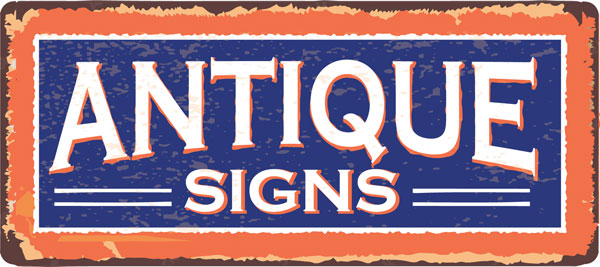Collecting vintage enamel signs is a rewarding and potentially lucrative hobby.
However, as the demand for vintage signs grows, so does the number of fake and counterfeit products flooding the market.
Whether you’re new to collecting or a veteran, knowing how to spot a fake is an essential skill when it comes to protecting yourself from dishonest sellers.
Here are a few of the more common and accessible methods used to spot fake enamel signs.
Research and compare
Online shopping can be challenging – without physical access to a sign, your best defence is a bit of research and comparison.
Take a look at reputable websites, sellers and forums to find genuine versions of the signs you’re interested in. Some authenticators and auction houses also allow you to browse their catalogues and past sales for a small fee.
This will allow you to compare all the visual elements such as the design, artwork, colours, fonts and mounting holes for obvious discrepancies. You can also check past sale prices to see if your sign is appropriately priced.
Additionally, you can seek out other examples from the same manufacturer or similar sign types as a general reference.
This approach isn’t foolproof since some fakes can be quite convincing and tracking down rarer signs for comparison can be difficult. Nevertheless, it’s often the most practical choice, particularly for newcomers.
Quality and craftsmanship
True vintage signs were made with care and craftsmanship. The artwork is detailed and precise, the letters are well defined and the edges are crisp.
Cheaper fakes are rarely made with the same level of professionalism. If you can see blurry or uneven text, rough edges or subpar artwork, there’s a good chance you’re not looking at an authentic sign.
Layering
Authentic porcelain enamel signs are known for their distinctive raised texture on the surface.
Typically, each different colour was applied as its own separate layer of enamel, resulting in height differences between the different coloured areas of a sign. You’ll be able to feel this difference, particularly at the border of the lettering.
While there are some exceptions, a perfectly smooth sign often indicates a fake.

Feel for raised lettering
Mounting holes
Mounting holes can be a giveaway when it comes to spotting a fake sign, but it might require some research.
Are the holes in the correct places? Is there the right number of holes? Or are there no mounting holes at all?
Genuine vintage signs can have uneven or unconventional mounting positions due to the various types of structures or supports used to display or mount them in the past. Each type of display stand for a sign could have different hole placements.
And genuine signs should have mounting holes – if it was never mounted, odds are it isn’t authentic.
Grommets
The mounting holes on most vintage signs were reinforced with grommets – small metal rings to protect the sign from wear.
If the grommets are genuine, they’ll often show their age – they’ll be worn, deformed, and may even have some rust underneath. If the grommets are missing, there should be visible evidence that they were once there.
If the grommets on your potential purchase look too new or undamaged, it may well be a fake.
Ageing and wear
Authentic signs typically show their age, displaying noticeable wear and tear. Signs in unusually good condition, especially at relatively low prices, are likely to be fakes.
However, an aged appearance is no guarantee of authenticity.
Counterfeiters use a range of methods to artificially ‘age’ their fakes – from deliberate damage to burying signs for months to mimic a weathered appearance.
Differentiating real ageing from fake can require a lot of experience, so just try to keep an eye out for unrealistic damage. For instance, early signs should have been protected by metal housing around the edges, so excessive damage in those areas should raise suspicions.
Stamps and signatures
Vintage signs sometimes feature a manufacturer’s stamp or ‘signature’, indicating the maker or date of registration. However, some fakes may have misspelled, inaccurate or suspiciously weathered stamps.
If your prospective sign has a stamp, compare it with other examples from the same manufacturer to check for discrepancies. If it should have a stamp but that area of the sign appears to be conveniently worn away – be wary.
Provenance and seller reputation
Where you can, buy from reputable sellers with a solid track record and known expertise. Check their reviews and history.
They should be able to provide the provenance of your potential purchase as well as a guarantee of authenticity – not to mention offer a refund if it turns out to be fake.
On the other hand, you should be very suspicious of unknown sellers. Look into their history, location and the rest of their catalogue if you can – a vendor from a less developed country offering a wide variety of very similar signs at similar prices is unlikely to be acting in good faith.
As with many things in life, the ‘caveat emptor’ (buyer beware) rule definitely applies when buying vintage signs for your collection. Fakes are all too common, so never take anything at face value.
Remember, if a deal looks too good to be true, it probably is.

